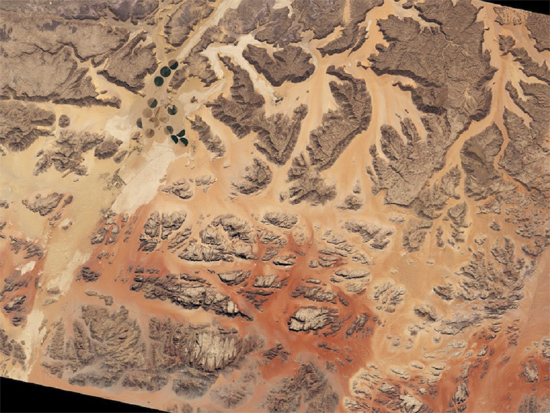|

Wadi Rum, Jordan. Credit: NASA EO-1
team and the United States
Geological Survey.
Jordan's Valley of the Moon
Apr 06, 2011
Middle
eastern deserts tend to preserve
their geography because there is so
little precipitation.
NASA's
EO-1 satellite returned
the above image of a
dry valley in Jordan.
Like many regions dominated by
deserts, the sinuous channels and
vertical cliff walls often found
there are usually attributed to
precipitation. Since there is so
little rainfall, it is presumed that
the geography we see today must be
ancient, otherwise there would not
be such deep canyons.
Wadi Rum is a collection of
granite and sandstone mountains,
with valleys choked in sand. The
highest peaks rise to about 1700
meters and are nearly vertical. Its
nickname, “Valley of the Moon,”
comes from the fact that it is so
barren and chaotic. Jabal Rum, one
of Jordan's tallest peaks, is a
chunk of sandstone 700 meters thick.
Its most unusual characteristic is
that it rests on a 40 meter high
granite slab.
The dry gullies (wadis) and steep
cliffs are thought to have been
carved by floods after the last Ice
Age. According to conventional
theories, as the glaciers melted the
runoff from the coastal mountains
carved a drainage system. The last
Ice Age is supposed to have ended
15,000 years ago, yet the sharpness
of the cuts into the stone and the
vertical cliffs belie a watery
birth.
Erosion is a blurring and
rounding process. Conical mountain
peaks are said to slowly reduce into
flattened mounds and finally wear
down to the level of the plains out
of which they rose. Steep, vertical
walls are supposed to gradually
become shallow slopes, and v-shaped
river valleys must give way to
meandering flood plains. If the
mesas, gullies, pillars, spikes, and
ridges have all been exposed to wind
and rain for millions of years, why
are they still so sharp, steep and
well-defined?
Erosion does not possess the
all-encompassing power for change
that modern geology asserts. In a
previous Picture of the Day, it was
proposed that curved gullies that
stretch out from a common center,
and sharp ridges with sine wave
undulations incised into them are
the remains of lightning bolts
cutting into the topography like a
plasma knife.
Lichtenberg figures have been
highlighted in these pages many
times. They are the forking shapes
that lightning bolts make when they
strike the Earth or some man-made
material. Their unique configuration
can be seen in acrylic blocks that
have been instantly charged with
thousands of volts at high amperage,
leaving a tracery of the electrical
pathway visible in the otherwise
transparent plastic. It seems
possible that
lightning bolts of
sufficient power could do the same
thing to minerals in the Earth on a
continental scale.
Indeed, Martian topography
demonstrates “erosion” patterns like
those in Jordan. The same
multi-branched canyons,
steep walls,
flat bottoms, sinuous
rilles and rims with scallop-shaped
cutouts are so much like the ones
seen here that transplanting Mars to
Earth or vise-versa would be
undetectable.
In the Picture of the Day about
the tepuis of Amazonia, it was
reported that on many of the summits
rock formations that look
more like abstract sculpture gardens
are abundant. Stone points, thickets
of tubular palisades and upraised,
columnar “hands” with multiple
fingers demonstrate that weathering
cannot be the primary cause. How
does erosion leave behind stacked
stone towers with many layers, sharp
edges, mushroom-shaped caps and fine
detail? Figures such as those should
have softened long ago.
The same
structures are
found in the Valley of
the Moon.
The focus of an ion beam large
enough to cut out and take away
sedimentary deposits weighing
billions of tons is not easy to
contemplate. The energy requirement
is so great that there appears to be
no way that it can be generated.
What could launch a bolt of
lightning that powerful? Indeed,
what could launch hundreds or
thousands of such bolts?
Earth bears witness to
catastrophic events in the not so
remote past, despite uniformitarian
views that assume slow, steady
effects.
Craters are declared to
be ancient and not recent. Mountain
ranges and valleys are asserted to
be older than the memory of man and
not newly minted out of a destroyed
and remade previous world, despite
the record of our ancestors.
As has been stated many times by
Electric Universe advocates, it is
time for another perspective on
geology. Some geologists question
the slow-motion theories that
dominate science today but they are
few. Since planetary scientists have
witnessed comet fragments colliding
with Jupiter, vast ionized plumes
erupting from Io, and volcanoes
spitting lightning, it seems
reasonable to insist that theories
involving fast acting forces of
change be considered along with
those that require millions of
years.
Stephen Smith
 New
DVD New
DVD
The Lightning-Scarred
Planet Mars
A video documentary that could
change everything you thought you
knew about ancient times and
symbols. In this second episode of
Symbols of an Alien Sky, David
Talbott takes the viewer on an
odyssey across the surface of Mars.
Exploring feature after feature of
the planet, he finds that only
electric arcs could produce the
observed patterns. The high
resolution images reveal massive
channels and gouges, great mounds,
and crater chains, none finding an
explanation in traditional geology,
but all matching the scars from
electric discharge experiments in
the laboratory. (Approximately 85
minutes)
Video Selections
Order Link
|





 New
DVD
New
DVD

